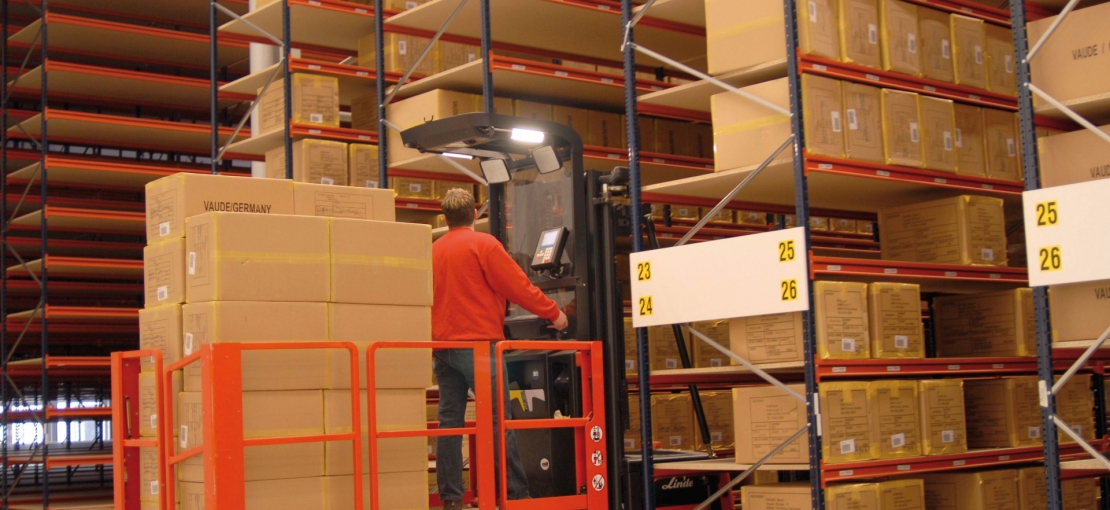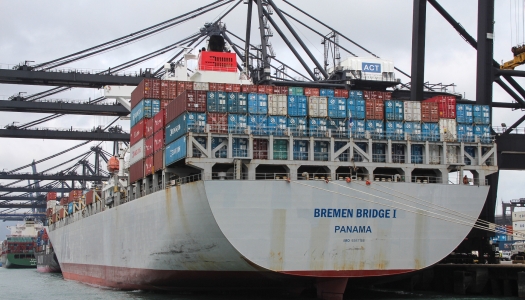
Halfway around the world – yet still eco-friendly
Low amount of emissions due to transport by ship
We live and work in a globalized world. Our products travel long distances and this transport is the source of emissions before they arrive at the customer.
The greatest percentage of our products by far travel the longest distances by container ship and train. This type of transport is responsible for a very low amount of emissions per individual product.
Public perception of sea freight
When it comes to public perception, however, the transport routes of Asian-made products have a higher relevance. Many people think that transport "halfway around the world" havocs significant environmental damage. In order to have some influence on this perception, we are reporting in detail on the aspect of transport.
Product transport routes
Upstream and downstream transport arises primarily from the delivery of goods commissioned by VAUDE to the warehouse in Tettnang as well as their delivery to our customers.
VAUDE products cover three major stages of transport:
- transport of components and materials to the producers
- transport of products from producer to VAUDE
- transport of products to the customer from VAUDE
In addition, emissions are caused by the delivery of all consumables required in Tettnang-Obereisenbach for our onsite production of bags and for the remaining company divisions: materials, buckles, packaging materials, building materials for the workshop, paper, furniture, coffee etc.
Route of materials to the producers
Majority of products travel by ship
The majority of the products that are sold in Europe are transported by ship from Asian producers to Hamburg. From the port of Hamburg, the products travel to Ulm by rail and are then delivered to Tettnang-Obereisenbach by truck.

|
“Arrival” by ship
Ship transport produces very few emissions, even when the trip goes half way around the world. |
Ecologically, transport by ship and rail makes the most sense. Whenever it is possible in light of customs legalities and organizational considerations, goods are delivered directly from producer to our major customers or to the recipient country without a detour into our warehouse, for example, to our customers within Asia - see also Our Markets.
Nevertheless, air freight is sometimes required in order to deliver goods on time to our customers. Sometimes this is unfortunately due to organizational problems, which we are continuously trying to avoid, so that air freight remains the absolute exception – costs alone are enough reason for this.
Offset emissions with myclimate
All relevant logistics data is collected from shipping companies and analyzed annually. All emissions from transport are calculated by myclimate in our annual climate balance. This helps us assess the evolution of transport and consequent emissions over several years - see also Greenhouse Gas Emissions in Detail.
In order to objectively evaluate the transport routes of our products in terms of production country and transport used, we had myclimate calculate which of our supplier scenarios causes more emissions. The results have confirmed our predictions.
Co2e per tonne of freight
Create your own infographicsLow transport emissions per product
This graphic makes it very clear that based on the weight of an individual product, ocean freight is only a tiny fraction per ton of freight. Once products are flown, however, emissions are high.
Rail is more eco-friendly than transport by truck
Together with our logistics service providers, we are working on a long-term "Green Logistics" project to further optimize all VAUDE goods transports under sustainability and emission considerations.
Products from VAUDE to customers
At our own warehouse in Tettnang-Obereisenbach, we have high impact on this environmental aspect. These processes have already been largely optimized by modern technology: deliveries from the central warehouse in Obereisenbach to our customers (retailers) are pack volume-optimized and collected by truck.
Improved data base of the logistics service provider
On the whole, we believe our goods transport is acceptable from a sustainability perspective. “Barriers " in the sense of transparency of environmental impact and the need for action are given to us by the plausibility checks of the EMAS certification and climate balance, which myclimate creates annually from all environmental data for VAUDE.
Data quality of the logistics providers has significantly improved in the past few years. However, the various methods of the service providers for collecting and evaluating their data on continue to be problematic.
By making compensation payments to myclimate, the goods logistics for all products that VAUDE manufactures in Tettnang-Obereisenbach are climate neutral, including the delivery of all materials, the internal transfer to storage, and shipping of the products to retailers. The proportion or goods manufactured elsewhere is, however, significantly higher – and not climate neutral. This remains a challenge for the coming years.
| GRI: | G4-EN4 |






